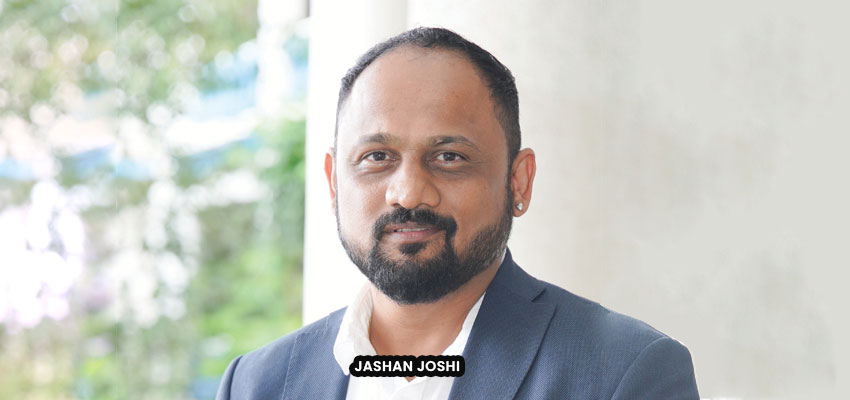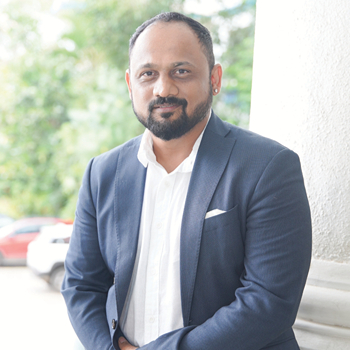Talent Sourcing is an Art

He recruits for a living, says Jashan Joshi, Talent Sourcing and Talent Intelligence Leader, ZS Associates, who is passionate about talent sourcing, recruiting and building high-impact teams globally. A certified sourcing professional, social hiring expert and talent intelligence enthusiast, he is exploring the impact of GenAI and ML in recruiting, while valuing human intelligence for a great candidate experience. In a one-on-one interview with Corporate Citizen, Jashan talks on how he drives talent acquisition, shape HR strategies, on sourcing processes, diversity hiring, HR tech, and why for him talent sourcing is an art
Corporate Citizen: You did your graduation (BSc) in Physics, followed by a diploma in media and mass communication, and then a course in videography from Film and Television Institute of India (FTII), before moving onto a career in human resource management. What inspired you to move to HR field?

Jashan Joshi: I did my BSc in Physics from Fergusson College, Pune. I wasn't particularly studious, but I was always drawn to media—especially photojournalism. So, I pursued a course in it and later added a videography course from FTII, given the growing buzz around electronic media. I began my career as a photojournalist with a leading publication. However, I wasn’t satisfied—I was passionate about investigative reporting, but was assigned entertainment beats. Eventually, I realised this wasn’t for me and decided it was time to reinvent myself.
Interestingly, I knew almost nothing about HR back then—except that HR takes interviews, just like I did in media. I once went for an HR interview at a small company, and when asked why I wanted to join HR, I honestly said, “It’s similar—I enjoy interviewing people.” The interviewer laughed, appreciated my honesty, and gave me a chance. That moment changed everything. I discovered my passion for HR, completed an executive course, and over the years, pursued multiple certifications to keep learning and growing in this field.
CC: In your 20+ years of experience in the HR field, starting with small stints with two companies, you worked for 5.5 years in Capgemini and presently working with ZS Associates, where you have been for last 12 years. Tell us the reason you stayed with one company for long years.
In today’s fast-paced world, patience and loyalty are often overlooked. For me, staying long-term is about continuous learning and growth. I’ve been fortunate to take on diverse projects and lead hiring across geographies like the US, UK, South America, and East Asia—experiences that have shaped my journey.
At ZS, what keeps me engaged is the constant push to evolve—past success is never the benchmark. It's always about what’s next, and that drive for progress is something I value deeply. Over the years, I’ve interviewed thousands of people, and hearing their stories has been one of the most rewarding parts of my job.
"What makes talent sourcing an art is the ability to craft a personalised outreach, understanding who you’re targeting and tailoring your approach accordingly"
— Jashan Joshi
CC: You are an ardent believer in the fact that talent sourcing is an art. How do you connect talent sourcing to art form?
Talent sourcing has evolved significantly— from newspaper ads to job portals, and now to digital platforms like LinkedIn and Instagram. Today, it’s about going where talent naturally spends time and using the right tools to find and engage them strategically.
What makes talent sourcing an art is the ability to craft a personalised outreach, understanding who you’re targeting and tailoring your approach accordingly. We’re in a multi-generational workforce now— what appeals to Gen X may not work for Gen Z or Gen Alpha. The messaging, the channel, and the tone all have to be adapted. That nuance, that creativity—that’s where sourcing becomes an art form.
CC: As an HR how do you design sourcing processes and hire using social media platforms?
Each platform serves a unique purpose. LinkedIn remains the primary tool for sourcing professionals, but finding contact details and reaching out effectively requires skill. Interestingly, Instagram has become the next big platform for talent attraction— especially for Gen Z and Gen Alpha.
While we don't actively hunt on Instagram, it’s a powerful engagement tool. By regularly sharing office culture and stories, we build a strong employer brand and attract followers. It’s about creating a pull factor. The key is knowing how to strike the right balance between professional and casual—to engage talent without crossing the line.
CC: As an HR did you face any challenges while sourcing and recruiting across the world?
If you're a candidate in India with say 25 years of experience, even at a senior level, I can still call you directly and say, “We have an opportunity; are you open to a conversation?” And, more often than not, you’ll say, “Sure, let’s talk.” That kind of immediacy is a hallmark of the talent culture here.
In contrast, the process in the West is more structured. It typically starts with an email outlining the opportunity. The candidate may then ask for additional details, and only after that do you schedule a call, sometimes the actual conversation begins a week later.
India operates in real time. The talent pool is vast and dynamic. Candidates here understand that if they don’t respond quickly, the recruiter will simply move on to the next person. That’s the pace, and the hustle in India.
Secondly, in my experience, Indians are the hardest working professionals and that’s a fact. India was once primarily seen as an offshore development hub, but today, we’ve evolved into a centre of expertise. That’s why our talent commands higher packages. We’re no longer viewed as low-cost labour—we’re recognised as highly skilled and premium talent. And, that shift is one of our greatest strengths.
On the other hand, markets in East Asia like Japan, China, and Singapore, tend to be much more conservative. Hiring there is complex and challenging, similar to the West. In contrast, India presents a win-win scenario for both recruiters and candidates, offering agility, depth of talent, and a strong work ethic.
CC: You hire candidates from diversified backgrounds and ensure that their talent and skills are being analysed instead of their background. Why diversity hiring matters? What is the business rationale behind diversity hiring?

Companies aren’t hiring women just to meet diversity targets—they’re hiring them because they deserve it. Women belong in the corporate world on merit. That said, traditional biases still exist. If a woman takes a 3–4 year break, many assume she can’t keep up.
Thankfully, things are changing. “Return to Work” programmes now offer women real opportunities, regardless of career gaps—the interview is the same, but the door is open. It’s about being empathetic and inclusive.
The same shift applies to LGBTQIA+ individuals and differently abled people. They were once overlooked, but now even clients ask about diversity ratios. Today, investing in inclusion and CSR isn’t optional—it’s a business mandate.
"Recruiting is about people and people need human connection. Candidates might appreciate automated steps, but when it comes to accepting an offer, they often want to speak to someone. It’s a life decision, not just a transaction"
CC: You do trust human intelligence and empathy over AI when it comes to candidate experience. What is the impact of Generative AI on the recruiting process?
Artificial intelligence has streamlined parts of the hiring process—just like ATMs simplified banking. But, recruiting is about people and people need human connection. Candidates might appreciate automated steps, but when it comes to accepting an offer, they often want to speak to someone. It’s a life decision, not just a transaction.
Recruiters too, need real conversations to assess cultural fit and intent. Human judgment can’t be replaced, especially in India, where many candidates from smaller towns may not be comfortable with fully automated interviews.
And, here’s the irony—people may be fine getting selected by a bot, but being rejected by one, not so much.
CC: So, important character trait to be an HR is that, first and foremost you need to be human.
Absolutely. At the core of HR is empathy. Being human comes first, because we're dealing with people, not just processes.
"India operates in real time. The talent pool is vast and dynamic. Candidates here understand that if they don’t respond quickly, the recruiter will simply move on to the next person. That’s the pace, and the hustle in India"
CC: HR is changing its structure almost every day in accordance with the changes in technology. How should those who aspire to start their career in HR, keep themselves updated?
To stay relevant, future HR professionals must be familiar with AI, especially the GenAI—it's no longer optional. HR isn't a single function anymore; it's a collection of specialised areas like talent acquisition,sourcing, talent intelligence, L&D, HR ops, HR analytics, total rewards and HR business partnering. Each of these uses AI tools today. For example, I use GenAI to create job descriptions—it used to take eight days, now it's done in 30 minutes. The company mapping projects used to take couple of weeks, now it is done in couple of days. Aspiring HRs need to choose their area of interest and upskill accordingly, especially with AI in the mix.
CC: Understanding and managing Gen Z employees require HR professionals to adapt to their preferences, values and expectations, to effectively engage and retain them. What strategies do you as an HR use to engage and retain them?
Recognising and adapting to evolving trends is essential. To engage and retain Gen Z, we focus on building a positive, inclusive culture, offering flexibility, meaningful work and continuous feedback. It's not just about pay—it's about purpose, growth and being heard. Understanding their values is key to keeping them motivated and connected.
CC: You stayed in one company for over 10 years. Will you expect the same from the Gen Zs?
Not really. We have to acknowledge changing workforce trends. In the U.S., around 68% of workers are gig workers or contractors—they prefer flexibility over long-term loyalty. Their mindset is to work for a year, take a break, travel and repeat. In India, the gig workforce is still smaller, around 7–8 percent, but Gen Z and Gen Alpha are increasingly leaning toward this model. They value freedom and experiences over staying with one employer long-term.
CC: Can you touch upon some of the HR trends like hybrid structure, employee experience, change management and people analytics?

The hybrid model is here to stay—most employees are back in office in some capacity. Fully remote or five-day office setups are rare. Hybrid offers the right balance but shouldn't lean entirely remote, especially in India where IT alone employs over five million people and contributes to the strong eco-system.
When it comes to employee experience, engagement has taken centre stage post-Covid. It's no longer just about employee friendly policies or benefits, it's about how employees feel every day at work. Companies are focusing more on emotional well-being, mental health, and building a sense of belonging. A positive day-to-day experience directly impacts retention and performance.
People Analytics—it’s not just about dashboards anymore; it’s about using data to predict behaviour, improve retention, and personalise employee experiences.
Change management is more critical than ever. With ongoing mergers, digital transformations, AI and a multigenerational workforce, HR must act as a stabilising force. It's about helping people navigate uncertainty and ensuring business continuity through empathy and structure.